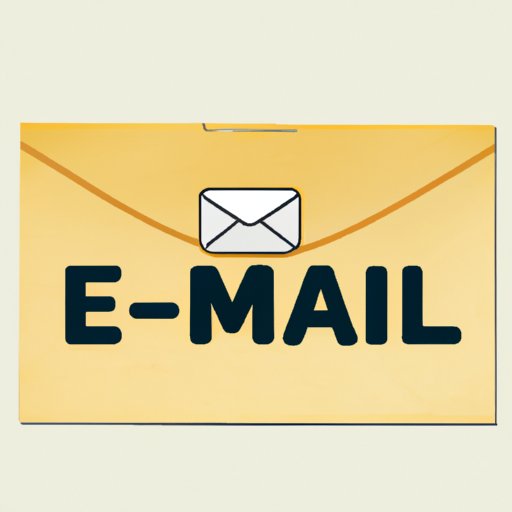
I. Introduction
Emails have become a ubiquitous form of communication in both personal and professional settings. While they are a convenient and efficient way to communicate, many people struggle with the task of crafting an effective email sign-off. A poorly crafted email sign-off can leave a negative impression on the recipient, while a well-crafted one can leave a lasting positive impression. In this article, we will explore the importance of creating effective email sign-offs and provide practical tips on how to end your emails with confidence and professionalism.
II. Polite Regards: How to Conclude Your Email Effectively
Using polite language in your email sign-off is crucial to maintaining a professional tone and showing respect to the recipient. Some effective and polite email sign-offs include:
- Best regards
- Warm regards
- Yours sincerely
- Kind regards
- With gratitude
Personalizing your email sign-off is also an effective way to create a more meaningful connection with the recipient. For example, if you have a pre-existing relationship with the person, you might choose to use a more personalized sign-off like “Take care” or “Stay in touch”. The key is to use language that is both polite and reflects the nature of your relationship with the recipient.
III. 6 Best Ways to Sign Off on Your Emails
There are many popular email sign-offs to choose from, but they’re not all created equal. Here are some of the most popular ones and the pros and cons of each:
- Best regards: A popular and professional sign-off that works well for formal emails.
- Sincerely: Another formal email sign-off that conveys a sense of seriousness and sincerity.
- Thanks: An informal sign-off that works well for friendly or casual emails.
- Warm regards: A slightly more personal and warm sign-off that works well for both personal and professional emails.
- Take care: A friendly sign-off that works well for personal emails or emails to close colleagues.
- Cheers: A casual and friendly sign-off that works well for personal emails or emails to colleagues and friends.
Choosing the best sign-off for your email depends on the context and the relationship you have with the recipient. If you’re not sure, it’s always better to err on the side of caution and choose a more formal sign-off.
IV. From Sincerely to Cheers: A Guide to Ending Your Email
From “Sincerely” to “Cheers”, there are many popular email sign-offs to choose from. Each sign-off conveys a different tone and communicates a different message to the recipient. Here’s a breakdown of some popular email sign-offs:
- Regards: A simple and professional sign-off that works well for formal emails.
- Best regards: A slightly warmer and more personal sign-off that also works well for formal emails.
- Sincerely: A formal and serious sign-off that conveys a sense of respect and formality.
- Yours truly: A formal sign-off that conveys a sense of respect and sincerity.
- Take care: A friendly sign-off that works well for personal emails or emails to close colleagues.
- Cheers: A casual and friendly sign-off that works well for personal emails or emails to colleagues and friends.
When choosing your email sign-off, it’s important to match the tone of your email with an appropriate sign-off. For example, a formal email should be concluded with a formal sign-off, while a casual email can be concluded with a more relaxed sign-off like “Cheers”.
V. The Dos and Don’ts of Email Sign-offs
While using email sign-offs may seem like a minor detail, it can actually have a big impact on how your emails are perceived by the recipient. Here are some best practices to keep in mind:
- Do be polite and respectful.
- Do personalize your sign-off when appropriate.
- Do match the tone of your email with an appropriate sign-off.
- Don’t use overly familiar language with people you don’t know well.
- Don’t use inappropriate or offensive language.
- Don’t use slang or abbreviations.
By following these best practices, you can create effective email sign-offs that leave a positive impression on the recipient.
VI. A Simple Guide to Signing Off Your Emails Like a Pro
Creating effective email sign-offs doesn’t have to be complicated. Here’s a simple guide to help you create effective email sign-offs:
- Consider the context and the relationship you have with the recipient.
- Match the tone of your email with an appropriate sign-off.
- Personalize your sign-off when appropriate.
- Keep it simple and avoid using slang, abbreviations, or overly familiar language.
- Proofread your email to ensure that your sign-off is appropriate and error-free.
By following these simple steps, you can create effective email sign-offs that help you communicate your message effectively and professionally.
VII. Warmest Regards to #The End: Tips for Ending Your Emails with Style
While traditional email sign-offs like “Best regards” and “Thanks” are effective and professional, sometimes it can be fun to get a little more creative with your email sign-off. Here are some creative and unique ways to end your emails:
- Warmest regards
- All the best
- Cheers to a great day
- Wishing you lots of success
- Until next time
- Stay safe
Using a creative email sign-off can make your emails stand out and leave a lasting impression on the recipient. However, it’s important to use these types of sign-offs sparingly and only when appropriate. A creative sign-off may not be the best choice for a formal or serious email.
VIII. Conclusion
Effective email sign-offs are an important part of professional communication. By using polite language, personalizing your sign-offs, and matching the tone of your email with an appropriate sign-off, you can create effective email sign-offs that leave a positive impression on the recipient. Remember to follow best practices, be mindful of the context and relationship you have with the recipient, and use creative sign-offs sparingly. With these tips in mind, you can end your emails with confidence and professionalism.




